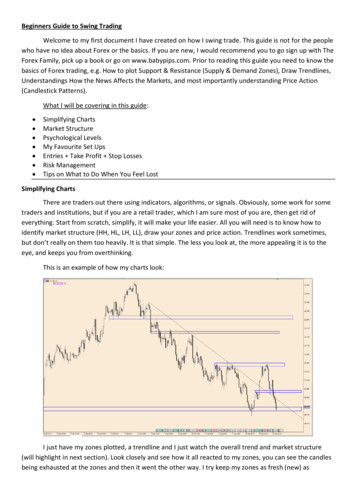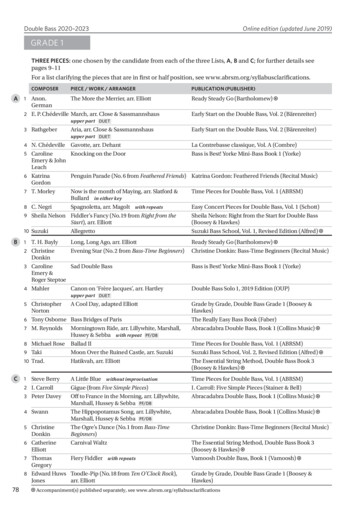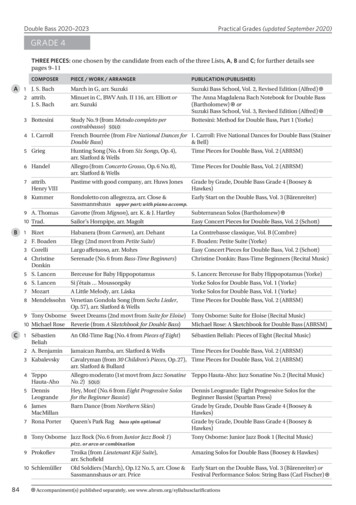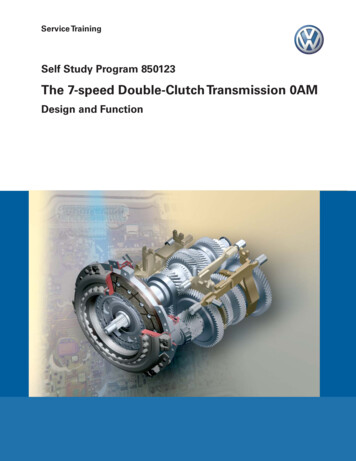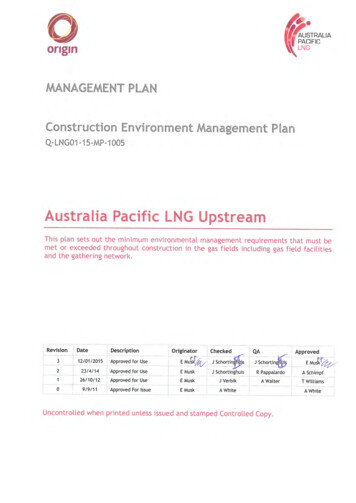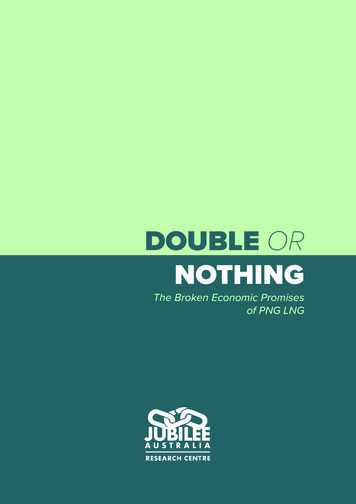
Transcription
DOUBLE ORNOTHINGThe Broken Economic Promisesof PNG LNG
This is a publication of the Jubilee AustraliaResearch Centre.Authors: Paul Flanagan and Luke FletcherDesign by: Dina Hopstad RuiApril 2018The information in this report may be printedor copied for non-commercial purposes withproper acknowledgement of Jubilee Australia.About Jubilee AustraliaJubilee Australia (formal name: the JubileeAustralia Research Centre) engages in research and advocacy to promote economicjustice for communities in the Asia-Pacificregion and accountability for Australian corporations and government agencies operatingthere.AcknowledgementsContacts us:We would like to acknowledge the people inAustralia and PNG, whose work, dedication,advice and assistance went into the development of this Report:Phone: ( 61) 02 8286 9706Email: inquiry@jubileeaustralia.orgMail to: PO Box 20885 World Square NSW 2002www.jubileeaustralia.orgLucielle Paru, Malcom Larsen, Brami Jegan, Rod Campbell, Kate Macdonald, BrynnO'Brien and Martyn Namyrong.PNG LNG constructionDOUBLE OR NOTHING: THE BROKEN ECONOMIC PROMISES PNG LNG
Table of contentsFIGURES 3TABLES 3EXECUTIVE SUMMARY 4SECTION 1: INTRODUCTION 101.1. TOO GOOD TO BE TRUE? 11SECTION 2: MACROECONOMIC IMPACTS 142.1. THE ACIL-TASMAN PREDICTIONS 142.2. ACTUAL MACROECONOMIC OUTCOMES 14SECTION 3: IMPACTS ON PNG GOVERNMENT BUDGET193.1. PREDICTION VS THE REALITY 193.2. DIGGING A LITTLE DEEPER: THE EITI DATA213.3. COSTS OF THE PROJECT TO THE BUDGET223.4. ESTIMATION OF FUTURE REVENUE 24SECTION 4: BROADER IMPACTS 264,1, SECTORAL IMPACTS 264.2. EXCHANGE RATE EFFECTS 284.3. EMPLOYMENT IMPACTS 29SECTION 5: WHY DID THIS HAPPEN? 315.1. FLAWS IN THE ACIL-TASMAN/PNGGEM MODEL315.2. GENEROUS TAX CONCESSIONS 315.3. THE USE OF TAX HAVENS 325.4 THE RESOURCE CURSE 335.5. GOVERNMENT OVERSPENDING 335.6. MANAGING THE IMPACT ON OTHER SECTORS365.7. INSTITUTIONAL WEAKNESSES 36SECTION 6: CONCLUSION AND RECOMMENDATIONS 386.1. RECOMMENDATIONS TO THE GOVERNMENT OF PNG396.2. RECOMMENDATIONS TO THE GOVERNMENT OF AUSTRALIA39APPENDIX 1: THE ACIL-TASMAN ANALYSIS AND PNGGEM 41APPENDIX 2: METHOD USED FOR THIS ANALYSIS 43ABBREVIATIONS 46WWW.JUBILEEAUSTRALIA.ORG3
FiguresPNG LNG - MAINLY NEGATIVES, NOT POSITIVES6SECTORAL PREDICTIONS VS ACTUALS7FIGURE 1: PNG'S ACTUAL GDP GROWTH RELATIVE TO ACIL-TASMAN PREDICTION 16FIGURE 2: LNG PRIVES - ACIL-TASMAN ASSUMPTIONS VS ACTUALS19FIGURE 3: ACIL-TASMAN ESTIMATE OF PNG LNG REVENUES TO GOVERNMENT20AND LANDOWNERSFIGURE 4: PNG LNG NET BUDGET REVENUES24FIGURE 5: PROJECTED FUTURE PNG LNG BUDGET NET REVENUES25FIGURE 6: DETAILS ON AGRICULTURE, FORESTRY AND FISHING27FIGURE 7: COMPARISON OF EXCHANGE RATE MOVEMENTS28FIGURE 8: THE PROJECT'S IMPACTS ON EMPLOYMENT19FIGURE 9: PNG LNG REVENUES VS TOTAL RESOURCE REVENUES34TablesTABLE 1: PREDICTED VS ACTUAL SHORT-RUN IMPACTS OF PNG PROJECT15TABLE 2: EITI REPORTS ON DIRECT REVENUE FLOWS FROM THE PNG LNG23PROJECTTABLE 3: EXAMPLE OF PNG LNG UBSA BUDGET COSTS24TABLE 4: PNG'S SECTORAL PERFORMANCE RELATIVE TO PNG LNG PROJECT26PREDICTIONSTABLE 5: ESTIMATES USED FOR DETERMINING UNDERLYING GROWTH PATH45WWW.JUBILEEAUSTRALIA.ORG 4
Executive summaryThe promises of PNG LNGMacroeconomic impactsThe Exxon-led PNG LNG project has, since2014, shipped about 7.9 million tonnes of natural gas per year from the gasfields of PNG’sHela region. The gas is liquefied at a plantnear Port Moresby and then shipped to buyersin Asia.The aim of this study was to compare the projected benefits for the early years of the PNGLNG project with the actual outcomes.The proponents positioned it as a major transformational project for the PNG economy,based around the central claim of a doublingof GDP.The upbeat figures found their way into thepolitical discourse of PNG. Caveats around assumptions were lost and the forecasts movedinto convenient promises for the project partners both in the lead-up to the approval of theproject in 2009 and onwards into the 2011/12election campaign.Now that some time has passed, there is anopportunity to measure the economic predictions for the project against the realities. Thisis what this report seeks to do.There are two key messages from this report.First, the flawed 2008 ACIL-Tasman/PNGGEMmodelling was extraordinarily over-optimistic - the “broken promises gap”. Such upbeatpredictions were never likely.Second, there is a “resource curse gap”. Thetemptations of such large and easy economicgains have returned PNG to poor policies typical of a resource curse. These poor policieshave pushed PNG below its underlying growthpath. In this sense, the PNG LNG project to datehas been bad for the economy and the peopleof PNG. Currently, on almost every measureof economic welfare in 2016, PNG would havebeen better off without the PNG LNG project.The study has found that over the ‘short-term’the economy has delivered very few of the outcomes that were predicted in the ACIL-Tasmanmodel – and none outside of the resourcesector.More specifically, after estimating an underlying growth path of how the economy wouldlikely have performed without the PNG LNGproject (as did the ACIL-Tasman analysis),based simply on how the economy was performing in the years prior to the project, thisanalysis has made the following findings:Despite predictions of a doubling inthe size of the economy, the outcomewas a gain of only 10% and all of thisfocused on the largely foreign-ownedresource sector itself;Despite predictions of an 84% increase inhousehold incomes, the outcome was a fallof 6%;Despite predictions of a 42% increase inemployment, the outcome was a fall of27%;Despite predictions of an 85% increase ingovernment expenditure to support better education, health, law and order, andinfrastructure, the outcome was a fall of32%; andDespite predictions of a 58% increase inimports, the outcome was a fall of 73%.The only area in which the ACIL-TasmanEXECUTIVE SUMMARY / DOUBLE OR NOTHING 5
PNG LNG - Mainly negatives, not l aggregate Real GDPforeign currencyexportsHouseholddisposableincome*PNG LNG PredictionThe only area in which the ACIL-Tasmanmodel underestimated gains was in theexport sector, where the prediction was ofa 106% increase in exports, and the outcome was an increase of 114%. This reflectsthe technical success of the project – starting earlier than expected and producingat above design specifications. This makesthe shortfall in other economic predictionsall the more remarkable.Government revenuesThe study’s findings about revenues are:The extremely disappointing governmentrevenues for the project cannot be putdown to either to low global gas prices orto cost blowouts in construction.Rather, expected government revenues,which were predicted to still be aroundK1.4 billion per year in 2016 despite low gasTotalAggregateReal aggregategovernment employment foreign currencyexpenditureimportsActual*proxy non-resource GDPprices, are in fact only about one-third atless than K0.5 billion.By the time one includes the interest costsof buying the government’s equity shareand direct payments to landowners, theproject has had a negative impact on thebudget of at least K200m in 2016. This situation is not likely to change until around2024. We estimate total net revenues of K23billion over the 30 year life of the project– about one-quarter of the original low oilprice case scenario and one-fifth the studymid-case scenario.Broader economic impactsAlthough the ACIL-Tasman study did predict a 20% decrease in agricultural exports,the impact of the project and governmentpolicy has seen agricultural exports decline by 40% compared to the underlyinggrowth path scenario. The government’sexchange rate policy likely worsened theEXECUTIVE SUMMARY / DOUBLE OR NOTHING 6
decline.Direct employment impacts were greaterthan expected, but the overall 27% fall inemployment as compared to the underlying growth path (i.e. no PNG LNG) scenariotranslates to an estimated loss of 140,000jobs.Why did this happen?Why is it that the project has been a remarkable technical success, producing higherlevels of export gains than expected, yet otherexpected benefits are either 90% lower thanexpected (GDP) or generally negative? Thecurrent failure of PNG LNG to deliver on itspromises is based on two key elements.The first phenomenon is the failure of PNGLNG project to meet the positive economicprojections of ACIL-Tasman and the projectproponents. This failure resulted from a number of causes:The serious flaws in the original ACIL-Tasman economic impact analysis which wasbased on a model of the PNG economycalled PNGGEM.A favourable tax regime and a generousfiscal agreement struck by the government,which left loopholes which the companieshave been able to take advantage of.The aggressive tax avoidance methods ofExxonMobil and Oil Search, such as theuse of subsidiaries, shell companies andtax havens in the Netherlands and the Bahamas to reduce their tax burden.The second phenomenon needing to beexplained is the fact that the economy performed worse than would have been expected without any new gas projects at all. Thecause of this result, it is argued, is poor policydecisions made by the PNG Government inresponse to the gas boom:The excessively optimistic promises of aSectoral predictions vs ce-40%PNG LNG PredictionActualEXECUTIVE SUMMARY / DOUBLE OR NOTHING 7
major new resource project led PNG policy-makers into poor decisions reflecting the“resource curse” experienced twice beforeby PNG and by other countries including:A profligate spending policy of a 57%increase in expenditures during the earlyyears of the project while revenues fell,which has burdened PNG with the largestbudget deficits in its history;unwise investment decisions such as amajor loss-making investment in Oil Searchshares;an exchange rate policy that has damagedother vulnerable sectors of the economy,worsening the effects of the Dutch Disease;andthe weakening of PNG’s financial governance institutions, including the CentralBank and PNG Treasury and a poorly designed sovereign wealth fund.and earlier share of the resource pie thancurrent agreements.1 No new resource projects should be approved until this framework is completed and publicly released.3. Projects should not be approved withoutthe production and release of transparent,verifiable, contestable and independenteconomic modelling by the government;this modelling should include a completelynew independent model that includes netcosts to the budget.4. PNG should urgently clarify some of theconfusing figures in the most recent EITIreports that royalties and developmentlevies paid by ExxonMobil are not beingreceived, and explanations provided as towhy the level of what should be identicalpayments are so different.Recommendations to theGovernment of AustraliaRecommendations to theGovernment of PNG1. The Australian government should developa code of conduct for economic modellersas recommended by the Australia Institute.This would include requirements such asdiscussion of assumptions used, a declaration of authorship and a requirementthat authors take responsibility for theplausibility of the results and the appropriateness of the presentation, including bythose who commissioned the work – thisincludes work by modellers for the PNGeconomy.1. PNG should return to more inclusive development policies while better managing theresource curse. There is a need to addressthe overvalued exchange rate, ensure thenew medium-term fiscal plans are implemented in a transparent fashion, andre-design the SWF to ensure all resourcerevenues flow to the budget.2. The Australian Government should immediately release the 2009 National InterestAssessment by DFAT which it providedto the Trade Minister recommending Eficsupport for the PNG LNG project. It shouldalso compel Efic to immediately release allrisk analysis it has compiled in connectionto the project.2. PNG should establish a clear policy framework for all future resource projects (andextensions) that ensures PNG gets a better1. For examples see Sir Nagora Bogan, Papua New Guinea Tax Review October 2015 and IMF, December 2017, p 8.All of these poor policy decisions are directly related to the PNG LNG project and theeconomic opportunities and challenges itpresented. The potential benefits of PNG’sresource wealth could in theory be able tobe tapped without damaging the rest of theeconomy. But it would require very differentchoices by the PNG’s policymakers.EXECUTIVE SUMMARY / DOUBLE OR NOTHING 8
3. The Australian Government should requirethat any further investments by Efic on theNational Interest Account are taken in thecontext of ensuring that local law has beenfollowed (such as land ownership determination before construction begins asrequired under PNG’s Oil and Gas Act).4. The Australian Government should crackdown on the use of tax havens.OilSearch facility near lake KutubuCredit: Damian BakerEXECUTIVE SUMMARY / DOUBLE OR NOTHING 9
Section 1: IntroductionThe PNG LNG project, which commencedproduction in 2014, extracts gas, condensateand naphtha from PNG’s Highlands and shipsthese products to a liquefaction plant nearPort Moresby by means of a purpose-builtpipeline. It is currently producing around 7.9million tonnes of LNG per year to buyers in Japan, South Korea and China and is projectedto run for 30 years.2 The lead operator is ExxonMobil, supported by the Australian/PNGcompany OilSearch: both have stakes in PNGLNG of just under on third. The Governmentof PNG also has a large stake in the project asdoes Australian gas giant Santos.The project was supported by an AUD 500million loan via Efic, Australia’s export creditagency, in 2009. 80% of this loan came fromEfic’s National Interest Account as directed bythe Trade Minister, who himself was authorised by the Australian cabinet. Other exportcredit agencies such as Ex-Im (US), JBIC (Japan) and SACE (Italy) also lent money to theproject, as did a consortium of private banks.A complete description of the main players inthe project is provided in Chapter 2 of JubileeAustralia’s Pipe Dreams report.3 A 2008 economic impact analysis report commissionedby ExxonMobil and authored by Australianconsultants ACIL-Tasman (now ACIL-Allen)predicted massive benefits that would flowfrom such a project, not just to shareholdersand financiers, but to the people of PNG. TheACIL-Tasman study predicted a doubling inthe size of the economy and windfall revenuebenefits to the PNG economy of K114 billionover 30 years.4 The ACIL-Tasman predictionsalso helped win over a key constituency: the2. ExxonMobil, PNG LNG Environmental and Social Report—Annual 2016, ocial-Reports.3. Luke Fletcher and Adele Webb, Pipe Dreams: ThePNG LNG project and the Future Hopes of a Nation, Jubilee Australia Research Centre, December 2012, chapter2 (henceforth: JARC, Pipe Dreams).PNG LNG landowners.5 An umbrella benefitssharing agreement (the UBSA) was signed inMay 2009.6These huge expectations permeated politicalrhetoric and expectations for the project, bothfrom the government and from the companies.In 2010, then-Treasurer Peter O’Neill said:We cannot understate the opportunity thePNG LNG project offers to transform oureconomy and substantially improve oursocio-economic development.7An example of the companies use of the ACILTasman material is provided by the head ofOil Search, Peter Botton. Botton made a presentation n 14 May 2008 to investors whichquoted directly from the ACIL-Tasman report(see box below).8 Botton was still quotingfrom the 2008 ACIL-Tasman figures in4. ACIL-Tasman, PNG LNG Economic Impact Study: AnAssessment of the Direct and Indirect Impacts of theProposed PNG LNG Project on the Economy of PapuaNew Guinea. Prepared for Exxon Mobil. Final Report.February 2008, vi. (henceforth: ACIL-Tasman, PNG LNGEconomic Impact Study)5. The initial 6 February 2008 report was updated inApril 2009. The only difference between the reports,possibly reflecting a desire to avoid sensitivities onthe design of any sovereign wealth fund, was that thefollowing sentences were deleted:“This essentiallyguarantees that the country can spend the real intereston its natural resources long after the oil resourceshave been exhausted. This is a good example of howa non-renewable resource can be transformed into afinancial asset that will last forever. Importantly, bycreating this fund Norway has minimised the negativeeffects of natural resource wealth by sending the rentsoffshore. Instead of driving up the exchange rate andmaking the country less competitive, the revenue simply drives up the value of the fund."6. Government of Papua New Guinea (GoPNG), PNGLNG Project Umbrella Benefits Sharing Agreement, May2009.7. Treasurer Peter O’Neill 2011 Budget Speech, 16 November 2010, p 22.INTRODUCTION / DOUBLE OR NOTHING 10
Box 1: Presentation by OilSearch titled "Economic Importance ofPNG LNG"- “Affects economy of PNG and its balance of trade situation profoundly“- GDP will more than double (K8.65bn (2006) to K18.2bn average during production phase).- Oil and gas export increase 4 fold (Average LNG and liquids value estimatedK11.4bn/yr).- Up to 7500 jobs in inital phase, 20% by nationals; 850 full time positions, developing national workforce over time.- Huge cash flows to Government - national and provincial - and landowndersthrough tax, royalties, levies and equity paricipation (direct cash payments ofUS 31.7bn/K114bn to PNG Governments/Landowners over 30 years).-Multiplier effects additional.February 2012:In the long-term the impact is quite substantial on the economy of PNG. ACIL-Tasman did an independent study some yearsago that suggested GDP would double as aresult of the project and, I think, over thelife of the project the state take, or staterevenue from the project, is something like US30 billion - so very very substantialover the 30 year life of the project.91.1. Too good to be true?Questions about whether the claims of theproject proponents and ACIL Tasman werereliable were initially made by Jubilee in PipeDreams back in 2012.108. OilSearch Ltd, Oil Search Asian Roadshow, May 2008,slide 32. http://www.oilsearch.com/ data/assets/pdf cef-d8b0-4f80-85fe-5f711e1f0fd8.pdf9. See Jemima Garrett, ‘PNG LNG Boss Speaks Out onLandowner Threats’, ABC Radio Pacific Beat, February15, 2012.10. JARC, Pipe Dreams, Chapter 3.PNG residents and observers might be surprised to be reminded of the bold predictionsmade about PNG LNG, with the country goingthrough a budget crisis which has seen publicspending slashed and services cut.11 This iseven more shocking given that an increase inpublic spending was supposed to be one ofthe major benefits.12Could the predictions about PNG LNG havebeen too good to be true?There are indeed some signs in PNG’s publicdiscourse that the PNG LNG project and thenew resources export boom it has come to11. Paul Flanagan, ‘From economic boom to crisismanagement in PNG’, East Asia Forum, 2 January economic-boom-to-crisis-management-in-png/.12. The NSO released in March 2018 a preliminaryupdated estimate of GDP in 2015 of K57.1 billion, some10% lower than the K62.3 billion in the PNG Treasuryestimates. This implies there was a serious recessionin non-resource GDP in 2015 – which would increasefurther the gap between promises and reality. However,the final version of the NSO report has not been released,and this study is based on the PNG Treasury numbers.INTRODUCTION / DOUBLE OR NOTHING 11
signify may not be living up to expectations.For example, PNG’s new Treasurer CharlesAbel, when presenting the 2017 Final BudgetOutcome to Parliament on 13 February 2018,seemed to warn the country that the resourcesboom may not be all that was promised. Hestated:In fact, on all major economic indicators apart from GDP and exports, thePNG economy is in a worse state thanit would have been if it stayed on theunderlying growth path of the 2000sand had no PNG LNG project.Having an abundance of natural resourcescan be a blessing or a curse. A child thatis given everything from birth never quitegrows up. A child that struggles learns tobecome strong and independent. PapuaNew Guinea must learn from the Africanexperience.Given these plans for further expansion of thegas sector, now would seem to be the perfecttime to analyse whether PNG LNG has livedup to all the grandiose promises. The reportis even more necessary when it is consideredthat there has as been little public examination of this question.14Moreover, as detailed in the body of the report(section 5.5 below), there have been, sinceat least 2010, some PNG public officials whohave questioned the rhetoric around the benefits to PNG and urged a cautious and pragmatic financial approach.Section 2 of this report provides an overviewof how the PNG LNG project has performedrelative to expectations across certain key economic measures. It finds that despite a massive increase in exports, the PNG economy didnot see the forecast improvements from PNGLNG. In fact, on all major economic indicatorsapart from GDP and exports, the PNG economy is in a worse state than it would have beenif it stayed on the underlying growth path of the2000s and had no PNG LNG project.However, many in the PNG Governmentcontinue to cling to the line that PNG LNGhas been good for the country. In a keynoteaddress to the PNG Petroleum and EnergySummit in March 2018, Petroleum MinisterFabian Pok described the PNG LNG project asa ‘huge success.’ Minister Pok’s speech wasmade in connection with a government whitepaper that which proposed that new gasfieldsin PNG be at least partly directed towardsdomestic energy usage.13Whether for domestic or for foreign sales,plans are certainly afoot to expand the development of PNG’s gas sector. There is anannounced plan to double LNG exports. Thecountry has a number of projects currentlyunder exploration, including ExxonMobil’sP’nyang gas in Western Province (which hasrecently had an 84% upgrade in potentialresources), Total’s Elk Antelope field also inGulf Province and Twinza’s Pasca offshorefield in Gulf Province.13. Barry Avery, ‘PNG’s new gas white paper plans toincrease use,’ Energy News Bulletin, 26 March 2018.14. One study we are aware of is a draft December 2017study by PNG’s National Research Institute of the economic impacts of PNG LNG. This has not been released(it is not on the NRI website) and only an ExecutiveSummary has been made available. The NRI draft studyis based on the PNGGEM – the flaws of this model arediscussed in Section 5.1 and Appendix 1. A secondanalysis was released just two days before the releaseof this report - t-or-inequality-in-papua-new-guinea . While done by a very credible author and emergingPNG leader, and the concerns about the resource curseare shared by this study, the methodology in the studywas simply to compare 2009 to 2013 data. However,as discussed in Section 2.2 and the Appendices, theACIL-Tasman model estimates are based on the timeafter the start of the production phase in 2014, not theconstruction phase. Making comparisons to 2013 picksup the once-off effects of construction activity - not theongoing implications for PNG's economy from the project. This is clearest when considering imports in 2013which were at a peak in bringing in parts for the PNGLNG liquification plant but have since dropped back to2006 levels.INTRODUCTION / DOUBLE OR NOTHING 12
The following two sections of the report extends this analysis. Section 3 examines in detail the important question of the lower thanexpected revenues. It lays out what revenueshave actually been paid and discusses whether the lower than expected revenues are likelyto continue. Section 4 examines more specificeconomic impacts of the project. It comparesthe differences between the predicted impactsthat the project would have on other sectors of the economy with the reality that hastranspired in PNG. It also looks at differencesbetween predicted and actual employmentfigures. Section 5 provides a number of explanations as to why the PNG LNG project has sospectacularly failed to live up to predictions.Section 6 contains the conclusion and recommendations.This report should be read in the light ofJubilee’s previous examination into the topic,its 2012 report Pipe Dreams: PNG LNG and theHopes of a Nation.This report is also the first in a series of reports to be released in 2018 about PNG LNG.The next paper in the series, to be releasedimminently, will look at the social impactsof PNG LNG in the Hela region and the otherproject areas. These two reports collectivelydemonstrate that many of the warnings aboutPNG LNG predicted by Pipe Dreams have nowcome to pass.INTRODUCTION / DOUBLE OR NOTHING 13
Section 2: Macroeconomic impacts2.1. The ACIL-Tasman predictionsThis report closely examines the predictionsof the 2008 Final Report done by ACIL-Tasman. This was a comprehensive study of theclaimed direct and indirect impacts of thePNG LNG project on the Papua New Guineaeconomy. The report was prepared for ExxonMobil but it became the key reference document for other project partners and the PNGgovernment itself.The ACIL-Tasman report used an economicmodel to estimate the overall impacts of thePNG LNG project. This included overall macroeconomic impacts as well as predictionsfor parts of the economy. The model used byACIL-Tasman is known by economists as aCGE model. A version of that model is stillbeing used in PNG.15 Appendix 1 discusses themodel in more detail. The report also coveredmore direct expected effects such as increasedtax revenue and direct employment gains.The two most prominent predictions of themodel were that PNG’s economy was expectedto be double the size of its underlying growthpath situation and that there would be an expected K114 billion increase in revenues overthe 30-year project life. In 2008, total budgetexpenditure was K7.6 billion. The expectednew revenues were 15 times the government’sbudget at the time.The ACIL-Tasman report also predicted largeincreases in household incomes (84%), government expenditure (85%) and in foreigncurrency exports (106%). Smaller, but nonetheless significant increases in aggregate15. CGE is the acronym for a Computable General Equilibrium model. The version in PNG is known as PNGGEM – so PNG’s General Equilibrium Model.employment and foreign currency importswere also predicted. These macro-economicpredictions are summarised in the middlecolumn of Table 1 below.2.2. Actual macroeconomicoutcomesHow do these predictions stack up with whathas actually happened in the PNG economyover the last 8 years? In order to answer thatquestion, we need to ask: how does the current economic situation in PNG with the PNGLNG project compare to what the economicsituation would have been without the project?This was also the approach of the ACIL-Tasman report. It created an underlying growthpath for the economy. It then used its modelto find out how different parts of the economywould be affected by the PNG LNG project. Ithad short-run predictions (about 2 years) andlong-run predictions (5 to 10 years). The reportthen expressed the “with PNG LNG” scenarioas “percentage changes from the underlyinggrowth path.” The short-run predictions fromthe model are shown in the middle column ofTable 1.In order to assess the ACIL-Tasman short-runpredicted percentage changes because of thePNG LNG project, this study needed to generate an underlying growth path for each of thepredictions of the ACIL-Tasman model.16The comparison is made with 2016 as it wasabout two years after gas started being exported in May 2014. Fortunately, generatingan underlying growth path is relatively simpleto do – it is just a form of trend analysis. Thestudy uses government data on how the PNGeconomy was performing in the 2000s beforethe PNG LNG project commenced its construc-MACROECONOMIC IMPACTS / DOUBLE OR NOTHING 14
tion phase (so before 2010) and assumes thisunderlying growth performance continued.Details on how this was done are given inAppendix 2. Essentially, the latest availableand consistent data from the PNG governmentwas gathered – preferably covering the period2005 to 2009.17 This data was converted into2016 prices to remove the impacts of inflationand commodity price fluctuations. The average value was then calculated. The averagegrowth rate was calculated. A simple formulathen uses the average 2000s value and growsit by the average growth rate for another 8 or9 years to get a 2016 estimate – an estimatebased on the “underlying growth path”. Anexample of this calculation for GDP is provided below. The results of this comparison16. ACIL-Tasman, PNG LNG Economic Impact Study, 21.It would have been easier if the ACIL-Tasman predictions were in terms of Kina values or numbers of jobsas these could have been easily compared with actualfigures in 2016. However, as just percentages wereprovided, work was required to estimate the “underlying growth path” and what value this would have beento match the “short-run” prediction. The short-run isdescribed as “about two years” after the project startedexporting gas.17. This was from the National Statistics Office, the PNGTreasury and the Bank of Papua New Guinea.between the underlying growth path and actual outcomes in 2016 are shown in the thirdcolumn of Table 1.The table shows an extraordinary gap between the ACIL Tasman predictions andactual 2016 o
tic - the "broken promises gap". Such upbeat predictions were never likely. Second, there is a "resource curse gap". The temptations of such large and easy economic gains have returned PNG to poor policies typ-ical of a resource curse. These poor policies have pushed PNG below its underlying growth path.


